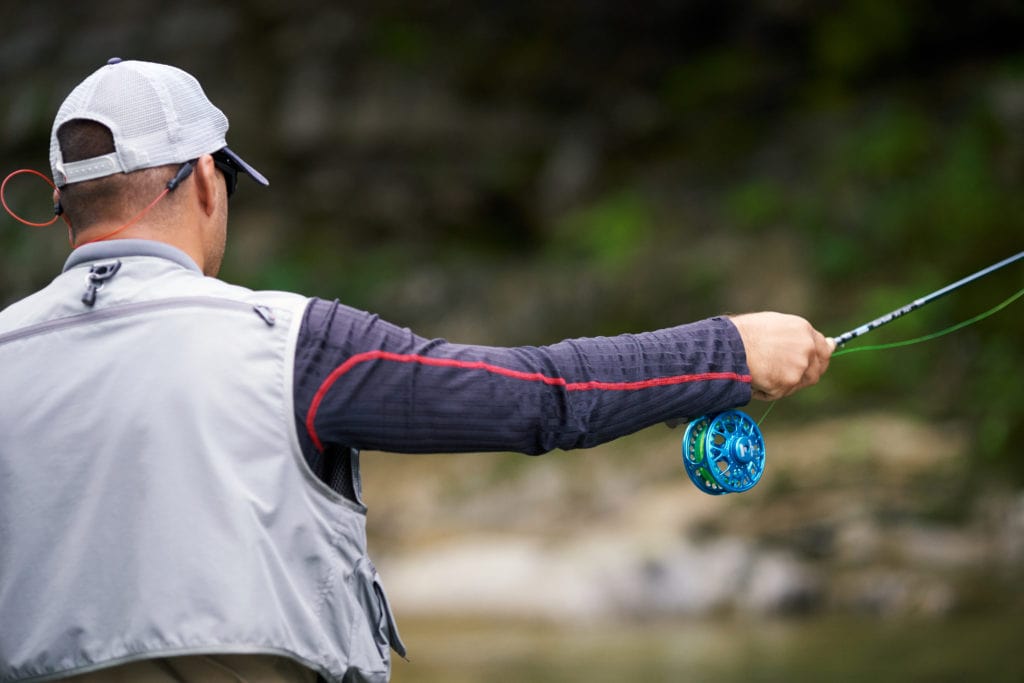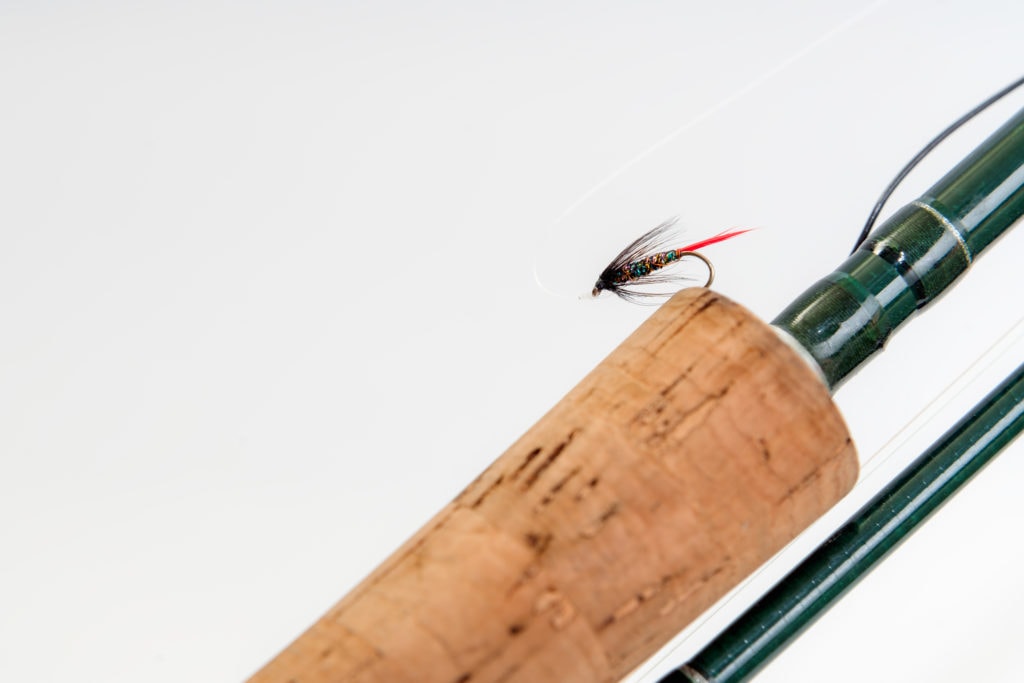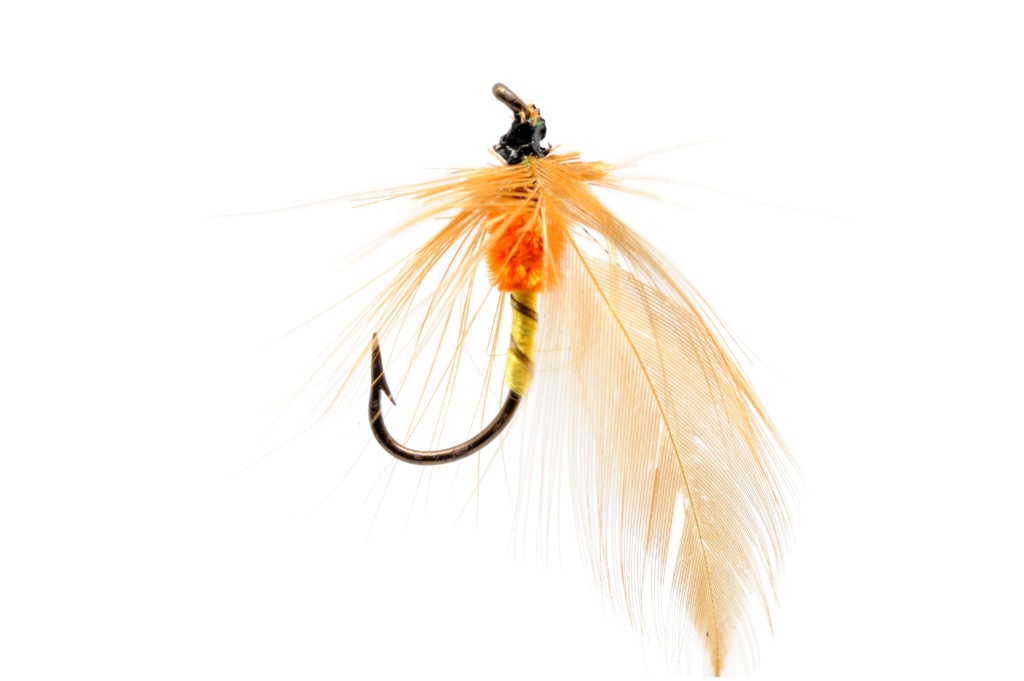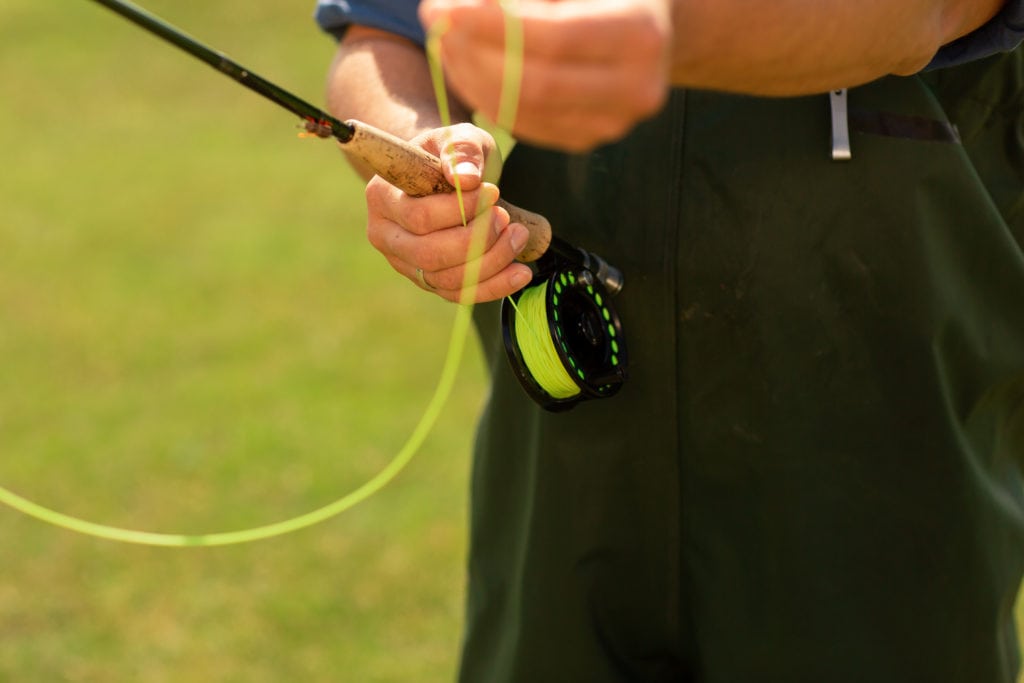Fly fishing takes practice but is extremely rewarding. You can fly fish in both freshwater and saltwater so nowhere is off limits.
If you’re new to the sport, you may wonder what exactly fly fishing is, what you need to get started, and how to set it all up, we’ve got the answers you’re looking for.

Know exactly what you are looking for? Use our table of contents to get you there in one click.
Fly Fishing Basics
As with any new endeavor, you will need some basic knowledge and supplies in order to get started. Having a basic understanding will help you prepare for your new fishing adventure before you head out.
What is Fly Fishing?
Well, fly fishing is…fishing but with a twist. Rather than the traditional method where bait is cast out and dangles below the water, in fly fishing your bait, a lightweight fly, sits atop the water. This mimics a scrumptious bug that has landed on the water and entices the appetite of various species of fish.

This type of fishing is artistic and certainly requires a certain flair. Due to the soft landing required by the fly and the most common hotspots to catch fish, oftentimes you will end up standing in the middle of a rushing river or creek testing the waters.
If you are looking for something to challenge yourself and open to trying something new, fly fishing is a great activity.
Basic Fly Fishing Equipment
Some fly fishing equipment may sound similar to traditional fishing equipment, though few items are actually suitable for both.
Here is some of the basic equipment you will need to begin fly fishing.
Fly Rod
Fly fishing rods are quite different from what you might have lying around. These rods are usually longer and lighter than traditional rods.
Fly Reel
Fly reels do not enclose the line. This is referred to as an open reel. Open reels are placed low on the rod and your hand is positioned above the reel, which is the opposite position from traditional fishing rods.
Fly Line
Weights and lures are used in traditional fishing to give weight to your line. In fly fishing, it is the line that provides the proper amount of weight. Rods can only handle specific line weights, so be sure your rod and line complement one another perfectly.
Backing

Fly line backing extends the length of your fly line and attaches it to the reel. The backing material is stronger and will not break as easily as the thin line you use for this sport, giving you more strength and control over your line.
Tippet
The tippet is a lightweight piece of line that attaches the leader to the fly. This is the thinnest line in your setup and is nearly invisible to your prey.
Leader
A leader is a piece of material or multiple materials that connect the fly to your fly line. This is generally clear and should be unnoticeable to the fish below the surface.
Flies
One of the most essential pieces of gear that sets this type of fishing apart is the flies which are used instead of traditional baits or lures. These often look like bugs or larva that fish naturally feed on.
Read Before Buying
Before you rush out and start buying pieces and parts, there are a few things to keep in mind.
How to Choose a Fly Rod
When choosing a fly rod, there are three main factors to take into consideration. You need to know the weight, length, and action of your rod to ensure it can handle the types of fish you will be targeting.
Weight
The weight of your fly rod doesn’t actually refer to how much the rod itself weighs but rather the weight of the line it is intended to be used with. If you recall, the weight of the line is vital to your fly fishing success so matching the rod’s recommended weight with the line you will use is the best recipe for success.

Length
The longer your rod, the easier it will be to cast further. However, this is not always desired. If you will be fishing in smaller rivers or creeks, you may not need to cast 14 feet or more.
Fly rod lengths are categorized into short (6-8 ft), medium (8-10 ft), and long (10 ft+). Rods over 10 feet long are usually spey rods for very long casting distances. Nine feet is the most common and popular rod length.
Action
The stiffness and flexibility of the rod is called the action. Action falls into four categories, slow action, medium or moderate action, medium-fast (moderate-fast) action, and fast action.
Fast-action rods are best for long casting or when additional power is required to counter wind or to reduce the physical demand on the fisherman. In this type, only the tip of the rod bends.
Medium-fast rods bend the top ⅓ of the rod and maintain slightly more power than a medium action while still allowing for a variety of uses. It is great for larger game or pulling fish from under heavy cover.
Medium or Moderate rods are versatile and much easier to cast. The rods bend to the halfway point of the rod. This gives a decent casting distance while still providing plenty of hooking power.
Slow action rods will bend almost to the handle of the rod. The slow recoil allows for the hook to set properly and is best used for smaller fishing game.
It is important to choose a rod that is perfectly matched to your intended use. If you are unsure, you can choose a rod in the middle so you can perfect your skills before switching to another option.
How to Choose Flies
Your best bet is to have a variety of flies tied and ready for whatever comes your way. By taking a bit of time to sit and watch, you can observe the type and size of the bugs landing in the water. This will help you understand which flies will be most effective for the area you are fishing.

Dry Flies
Dry flies rest on top of the water and fish will arch out of the water to catch them. These are the most common type.
Nymphs
Nymphs float just below the surface of the water. Fish most often prefer to munch on their food subsurface. This type is almost a guarantee at attracting some nearby game.
Streamers
Streamers mimic the movement of small aquatic life as you pull the line in. This draws the attention of fish hungry for moving bait. Streamer fishing attracts larger fish so if you’re tired of catching tiny fish, try one of these to bring in a larger catch.
Fly fishing is unpredictable and what worked one day may not work the next. Having a variety of colors, sizes, and types of flies ensures you are ready for whatever your fishing day brings.

Getting Ready
Now, you’ve gathered your supplies and you know the basics, now what? Well, your next step is to get everything set up. This is not for the faint of heart but is essential to your success when fly fishing.
How to Set Up a Fly Fishing Rig
Grab your supplies and be sure your line, reel, and rod all match up to what your rig can handle. Now you’re ready to assemble the whole kit and kaboodle.
- First attach the backing line to the reel. Generally, this is done using an Arbor knot. Even if using another knot, be sure the backing is securely attached to the spool arbor.
- Next, attach the line to the backing with a knot or a loop and spool the line onto the fly reel.
- Attach a leader and tippet to the end of the fly line.
- Grab your rod and assemble each piece. Some have dots to line up to ensure the rod is properly assembled. If it does not, be sure you keep each piece aligned.
- Slide the reel onto the reel seat and use the slide band and lock nut to securely attach it to your rod.
- Work your line up and through each guide starting from the bottom.
Now you’re all set and ready to cast. For a visual view, check out the video below. Also, here is a more detailed look at setting up your fly reel to help you out.
How to Cast a Fly Rod
Casting a fly rod takes some practice to get right. Some people equate it to an apple speared to a stick. Your goal is to fling the apple as far as possible. Moving too quickly will cause the apple to fall off behind you.
You must start slow and accelerate as you move forward. If you come to a slow stop, the apple may never be ejected from the stick. The sudden stop is what causes the forward motion in both the apple and your fly line. Here are some steps to help you cast your fly rod.

- Get a Grip – Having a proper grip on the rod is essential to the cast. Use your dominant hand and wrap your fingers around from the bottom like a handshake. Keep your thumb on top of the rod.
- Control the Line – Your non-dominant hand will be used to control the line. Pull 10-15 feet of line from the spool, keeping a loose hold on it.
- Backcast – A back cast has two distinct stops, one right before the 2 o’clock position behind you and once when the rod reaches its forward extended position. This projects the line forward like releasing the apple in the analogy above. When the line is stopped behind you, quickly flick your wrist and forearm forward.
- Load the Rod – Use your non-dominant hand to hold the line securely, causing the rod to bend to its full capability. This is what will create the torque necessary to reach your desired location.
- False Casts – Perform this motion a few times. Each stroke allows you to extend your cast, gauge the distance and angle, and adjust your fly to ready for the final cast.
Now all you have to do is wait for a bite. Be sure to practice your cast often to get the best distance and control.
Conclusion
Fly fishing is an exciting niche that you can enjoy in nearly any body of water. You will need some special equipment to get started but it is well worth the initial cost and learning curve. It is also an excellent way to enjoy the outdoors and relax on holidays and weekends.
As you spend time in the sport, you will likely branch out to other supplies to make your fly fishing trips easier and more productive. If you’ve already gotten started in fly fishing, you are likely aware of the plethora of other items that enhance the sport, such as a fly fishing backpack, chest pack, or sling to keep all your items contained, fly tying kits to help you tie your own flies, waders, vises, and much more.
There are endless ways to up your game and no matter how much you learn, you can always get better. Thanks for stopping by. Happy fishing!

Big Game Logic is a participant in the Amazon Services LLC Associates Program, an affiliate advertising program designed to provide a means for us to earn fees by linking to Amazon.com and affiliated sites. Pages on this site may include affiliate links to Amazon and its affiliate sites on which the owner of this website will make a referral commission
